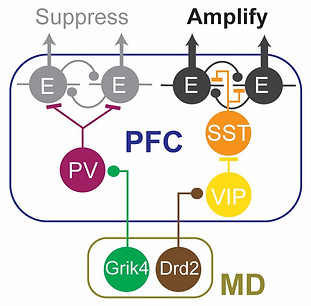1. Molecular Signatures and Connectivity Maps of Cognitive Control Circuits

Figure: Technical approaches for cell type specific circuit dissection of adaptive behavior (Mukherjee and Caroni, 2018, Nat. Commun., Mukherjee et al., 2020, eLife; Mukherjee*, Lam* et al., 2021, Nature; Lam*, Mukherjee* et al., 2024, Nature)
How does the activity patterns generated by the PFC transform into cognitive control signals? This is a central challenge in systems neuroscience and one of the main focus areas of our lab. Uncovering the principles of such transformations could provide key insights into the computational algorithms and neurobiological substrate of cognition and its dysfunction in psychiatric disorders.
To this end we combine activity based tagging of neural ensembles, single cell transcriptomics, in vivo electrophysiology and well parameterized behavior tasks to probe the cell type specific microcircuits across the PFC, thalamus and the hippocampus that underlie cognitive control over:
1. Perceptual and Motivational decision making, and
2. Long term memory consolidation towards rule learning.
2. Principles Governing the Maturation of Cognitive Control Across Adolescence

Figure: Cell type defined circuits between the MD and the PFC that support decision making under perceptual uncertainty. (Mukherjee*, Lam* et al., 2021, Nature)
Adolescence is a critical period in development marked by heightened exploration and risk-taking behaviors. Such behaviors are theorized to be evolutionary adaptations essential for refining cognitive control over survival and reproductive success. We, at the Mukherjee lab, investigate the emergent properties of the adolescent PFC that drive increased exploration and risk taking. We specifically focus on:
1. Thalamocortical circuits that support decision making in noisy environments.
2. Dopaminergic modulation of prefrontal circuit function in adolescence.
3. Cell-type specific sensitive periods of vulnerability of the PFC

Figure: Temporal evolution of the PFC's internal state due to maladaptive development and targeted interventions. (Mukherjee et al., 2019, Cell)
Protracted maturation of the PFC across adolescence renders it vulnerable to disruptions from stressors encountered at this age, such as substances of abuse. Notably, many psychiatric disorders, like schizophrenia, that are marked by cognitive deficits first emerge during this period. Our research specifically focuses on the transitory period between adolescence and adulthood to:
1. Identify temporal windows when cell type–specific PFC circuits deviate from typical development in models of neurodevelopmental and psychiatric disorders.
2. Developing circuit-specific interventions during adolescence that promote long-term cognitive enhancement.
